Related Research Articles

Neijia is the collective name for the internal Chinese martial arts. It relates to those martial arts occupied with spiritual, mental or qi-related aspects, as opposed to an "external" approach focused on physiological aspects. The distinction dates to the 17th century, but its modern application is due to publications by Sun Lutang, dating to the period of 1915 to 1928. Neijing is developed by using neigong or "internal changes", contrasted with waigong or "external exercises".

Tai chi is an internal Chinese martial art practiced for self-defense and health. Known for its slow, intentional movements, tai chi has practitioners worldwide and is particularly popular as a form of gentle exercise and moving meditation, with benefits to mental and physical health.

The Sun-style tai chi is one of the five primary styles of tai chi. It is well known for its smooth, flowing movements which omit the more physically vigorous crouching, leaping and fa jin of some other styles. Its gentle postures and high stances make it very suitable for martial arts therapy.
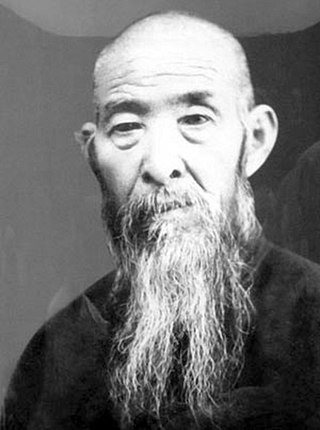
Sun Lutang (1860-1933) was a master of Chinese neijia (internal) martial arts and was the progenitor of the syncretic art of Sun-style tai chi. He was also considered an accomplished Neo-Confucian and Taoist scholar, and was a distinguished contributor to the theory of internal martial arts through his many published works.
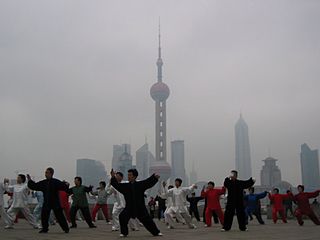
There are hundreds of different styles of Chinese martial arts, each with their own sets of techniques and ideas. The various movements in kung fu, most of which are imitations of the fighting styles of animals, are initiated from one to five basic foot positions: normal upright posture and the four stances called dragon, frog, horse riding, and snake. The concept of martial arts styles appeared from around the Ming dynasty (1368–1644). Before the Ming period, martial skills were commonly differentiated mainly by their lineage. There are common themes among these styles which allow them to be grouped according to generalized "families", "fractions", "class", or "schools" of martial art styles. There are styles that mimic movements from animals, or otherwise refer or allude to animals or mythical beings such as dragons, and others that gather inspiration from various Chinese philosophies or mythologies. Some deeply internal styles tend to focus strongly on practice relating to harnessing of qi energy, while some more-conspicuously external styles tend more to display skills and abilities in competition or exhibition.
Chen Weiming (1881–1958) was a scholar, tai chi teacher, and author. He was also known by his name Chen Zengze (陳曾則), Weiming being his hao, a pen-name.
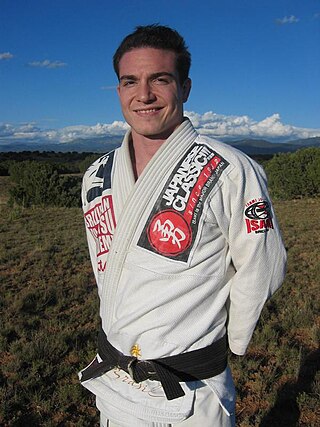
Alberto Lewis Crane is an American former mixed martial artist, submission grappler and Brazilian Jiu-Jitsu instructor. He has fought in the Ultimate Fighting Championship and is a former King of the Cage and Ring of Fire lightweight champion. He is the founder of Legacy Jiu-jitsu Academy.
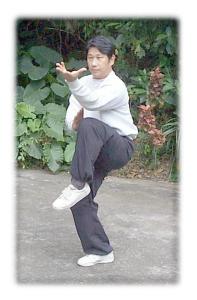
Luo Dexiu or Lo Te-Hsiu is a Taiwanese martial artist who specializes in the internal Chinese styles of Xingyiquan, Baguazhang, and Taijiquan.
Marcio Feitosa is a Brazilian 6th degree black belt in Brazilian jiu-jitsu. He has learned directly from Carlos Gracie Jr., founder of the Gracie Barra Academy in Rio de Janeiro. He has risen to the podium eight times from 1997 to 2006 at several world championships.

Leandro Vieira is a Brazilian jiu-jitsu instructor and competitor, and a co-founder of Checkmat. He is also the Brazilian jiu-jitsu head coach for the MMA team at American Kickboxing Academy, renowned for being one of the most successful teams in the world.
The Central Guoshu Institute was established in Nanjing by the Kuomintang government of the Republic of China in March 1928 for the propagation of Chinese martial arts, and was an important center of martial arts during the Nanjing decade. Guoshu "national art" was the term for martial arts adopted by the Republic of China at the time. The institute was created by Zhang Zhijiang under the sponsorship of elite government officials such as Li Liejun and others. Along with the Jing Wu Athletic Association, the academy played a crucial role in the transmission of traditional Chinese martial arts into the 20th century.
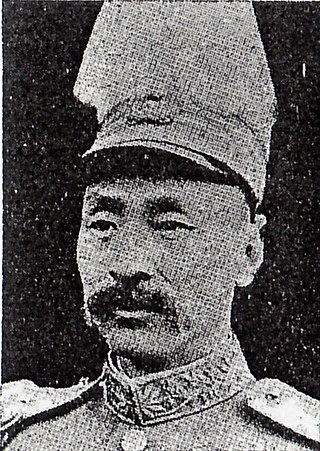
Li Jinglin, also known as Li Fangchen (1885–1931) was a deputy inspector-general and later army general for the Fengtian clique during the Chinese warlord era. He hailed from Zaoqiang County, Hebei province, China. After his military career was over he settled in Nanjing, and in 1927 moved to Shanghai. A renowned swordsman, he was known as "China's First Sword."

Wudangquan is a class of Chinese martial arts. In contemporary China, Chinese martial arts styles are generally classified into two major groups: Wudang (Wutang), named after the Wudang Mountains; and Shaolin, named after the Shaolin Monastery. Whereas Shaolin includes many martial art styles, Wudangquan includes only a few arts that use the focused mind to control the body. This typically encompasses tai chi, xingyiquan and baguazhang, but must also include bajiquan and Wudang Sword. Although the name Wudang distinguishes the skills, theories and applications of the internal arts from those of the Shaolin styles, these arts did not originate in the Wudang Mountains: the name Wudang comes from a popular Chinese legend that purports the genesis of tai chi and Wudang Sword by an immortal, Taoist hermit named Zhang Sanfeng who lived in the monasteries of Wudang Mountain. Wudang quan is often used synonymously with Neijia, but Neijia is a broader term that also encompasses Aikido and Qigong, which are not Wudang quan.

Xingyiquan, or Xingy, is a style of internal Chinese martial arts.
Lana Stefanac is an American mixed martial artist, grappler and black belt Brazilian jiu-jitsu practitioner and instructor. Stefanac is a World, Pan American, and US National Brazilian jiu-jitsu Champion in colored belts, she is a two-time black belt world champion and the first American woman to become world champion in both her weight class and in the Open class.
Cheng Wing Kwong was a disciple (Tudi) of Wu Jianquan, the founder of Wu Style Taijiquan. He was born in Niao Shi, Zhongshan, Guangdong, China.
Peter de Been is an Australian martial artist who helped pioneer the art of Brazilian Jiu-jitsu in Australia.
Bianca Barbosa Basílio also known as Bia Basílio is a submission grappler, mixed martial artist and Brazilian Jiu Jitsu (BJJ) black belt athlete.
Emily Kwok is a Canadian submission grappler and 3rd degree black belt Brazilian jiu-jitsu (BJJ) instructor. A former mixed martial arts (MMA) competitor with a perfect record, Kwok is the first Canadian woman to receive a Black Belt in Brazilian Jiu-Jitsu and the first to become World Champion. As one of the first women to rise to prominence, Kwok is widely regarded as an early pioneer of the BJJ scene in North America.
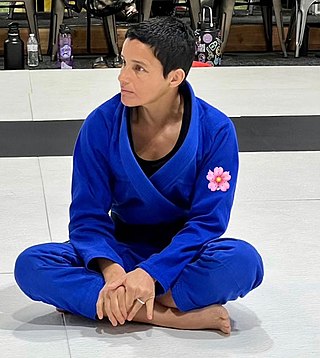
Alessandra "Leka" Vieira is a submission grappler and a 6th degree Brazilian jiu-jitsu practitioner and coach. Widely regarded as one of the pioneers of women's Brazilian jiu-jitsu, she became in 1999 the first-ever female black belt World champion.
References
- ↑ "Pan American 2003 results". Ibjjf.org. Archived from the original on May 16, 2015. Retrieved 2012-11-21.
- ↑ "Pan Jiu-Jitsu Championship 2004 – Results". Ibjjf.org. Archived from the original on May 24, 2017. Retrieved 2012-11-21.